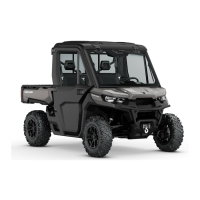SAFE OPERATION - RESPONSIBILITIES
– Never operate on excessively
rough, slippery or loose terrain un-
til you have learned and p racticed
the skills n ec es sary to control this
vehicleonsuchterrain. Alwaysbe
especially cautious on these kinds
of terrain.
– Never operate this vehicle on hills
too steep for the vehicle or your abil-
ities. Practice on small inclines.
– Always fo llow p roper procedures
for clim bing o r going dow n hills as
described in
RIDING YOUR VEHI-
CLE
. Check the terrain carefully be -
fore you start up or down any hill.
Never climb or descend hills with
excessively s lippery or loose sur-
faces. Never go over the top of any
hill at high speed.
– Never attempt ste ep hills or side
hilling when pulling a trailer.
– Always check for obstacles before
operating in a new area. Always
follow proper procedures when op-
erating over obstacles as described
in
RIDING YOUR VEHICLE
.
– Never operate this vehicle in fast
flowing water or in water deeper
than specified in
RIDING YOUR VE-
HICLE
. Remembe r t hat wet brakes
may have reduce d stopping ability.
Te st your bra kes after leaving wa-
ter. If necessary, apply them sev-
eral times to let friction dry out the
brakes.
– Always ens ure to properly park the
vehicle on the flattest terrain section
available. Put shift lever in PARK,
stop engine and remove key before
leaving the vehicle.
– Never assume that the vehicle will
go everywhere safely. Sudden
changes in terrain caused by holes,
depressions, banks , softer o r harder
“ground” or other irregularities may
cause the vehicle to topple or be-
come unstable. To avoid this, slow
down and alw a ys observe the ter-
rain ahead. If the vehicle does begin
to topple or rollover, the best advice
is to immediately steer in th e dire c-
tion of the rollover! Never attempt
to prevent a rollover with you r arms
or legs. You should k eep your limbs
inside the cage or ROPS (rollover
protective structure).
________
SAFETY INF
ORMATION
________
13

